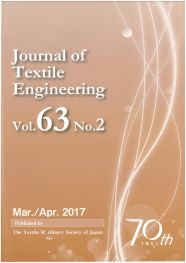
- Issue 6 Pages 149-
- Issue 5 Pages 121-
- Issue 4 Pages 93-
- Issue 3 Pages 63-
- Issue 2 Pages 33-
- Issue 1 Pages 1-
- |<
- <
- 1
- >
- >|
-
Saori KITAGUCHI, Mariko KUMAZAWA, Hiroyuki MORITA, Manami ENDO, Tetsuy ...2017 Volume 63 Issue 2 Pages 33-41
Published: April 15, 2017
Released on J-STAGE: July 14, 2017
JOURNAL FREE ACCESSValue of fabric related to quality and aesthetic were investigated especially focusing on fabrics made from wool or from wool as the main material. Two sensory evaluations, comprising of a visual evaluation and visual with tactile (visual-tactile) evaluation were carried out in aspects of quality and aesthetic and also fabric hands using verbal expressions that people generally use. The visual and visual-tactile feelings of quality (high grade/low grade) and aesthetic (feels beautiful or fine/does not feel beautiful or fine) were found to be correlated well with the feelings of rough/smooth and coarse/fine; namely, the more smooth and fine the samples were, the more the subjects felt them as higher grade and more beautiful. On the other hand, quality and aesthetic feelings were independent from thin/thick, strong/week and heavy/light feelings of the samples. This study also suggested the important physical and surface properties for the quality and aesthetic feelings. The surface property, SMD, found to relate to the quality and aesthetic feelings of both visual and visual-tactile evaluations. Prediction models were also introduced. The quality and aesthetic feelings were described well with the models by taking into account not only the surface property, SMD, but also the properties such as shear properties for the visual evaluation and the shear property, the air resistance property and/or the bending property for the visual-tactile evaluation.
View full abstractDownload PDF (1238K) -
Limin BAO, Shunsuke SATO, Yaling WANG, Kaoru WAKATSUKI, Hideaki MORIKA ...2017 Volume 63 Issue 2 Pages 43-48
Published: April 15, 2017
Released on J-STAGE: July 14, 2017
JOURNAL FREE ACCESSMost stab-proof vests in use are made from metal plates, whose weight, bulk, and rigidity make them unsuitable for use over extended periods of time. Light, thin, and flexible clothing that protects against knives and other sharp objects is needed. However, achieving high levels of puncture resistance and comfort remains a challenge. While plain textiles can resist slashing, they cannot withstand stabbing. In this study, we investigated the stab resistance of aramid fabrics impregnated with micro-glass particles and nano-silica particles and evaluated the influence of particle size and mass concentration by measuring the load, displacement, and energy when the samples were struck by a blade. Particle-impregnated fabrics showed good puncture resistance. The smaller the diameter of the particles, the greater the material’s resistance to penetration. Movement of yarn strands is inhibited by impregnation with particles. Furthermore, the friction force acting on intersecting sections of plain fabric exhibits the largest influence on stab resistance.
View full abstractDownload PDF (1798K) -
Etsuro SUGIMATA, Hisai UEDA, Wataru KURIYAMA, Wataru OKUMURA, Mitsugu ...2017 Volume 63 Issue 2 Pages 49-54
Published: April 15, 2017
Released on J-STAGE: July 14, 2017
JOURNAL FREE ACCESSCarbon fiber reinforced thermoplastic (CFRTP) is able to change a shape after molding by re-heating. By using the characteristic, we contrived a CFRTP pipe which can be re-shaped at an on-site, for example, in construction work or in earthwork. In this study, we estimated bend property of CFRTP pipe. The CFRTP pipes which had various Vf and braiding angle were prepared by using braid with commingled yarn, and by using low compression molding with heat shrink tube. The commingled yarn was composed of carbon fiber and polyamide12 fiber. The CFRTP pipes had 4 plies, 25mm of outside diameter, and 22mm of inside diameter. The CFRTP pipes were bent into U-shaped of radius 90mm, after heating 190°C. As the results, CFRTP pipe which had 40% of Vf and 50 degrees of braiding angle could be bent well without fold or void.
View full abstractDownload PDF (1897K) -
Hiroki MARU, Shoji SAITO, Hiroyuki KANAI, Toyonori NISHIMATSU2017 Volume 63 Issue 2 Pages 55-62
Published: April 15, 2017
Released on J-STAGE: July 14, 2017
JOURNAL FREE ACCESSProperty of fabric appearance such as elegant, high-class, beautiful is required on producing dyed black color fabric for formal wear. From our previous study, the hierarchical model representing the quality check process of fabric appearance was proposed through evaluation of dyed black color fabrics by non-experts on textiles. And it was found that the evaluation of fabric appearance is strongly governed by that of macroscopic or microscopic brightness sensation. Hence, this study aimed to predict the score of the macroscopic or the microscopic brightness sensation by optical measurement and its characterization of dyed black color fabric. The spatial reflection curve on 12 kind of sample was measured with original gonio-photometric system. And several parameters (e.g. TI, S, and I) indicating the character of the spatial reflection curve was defined. Then the score of the macroscopic or the microscopic brightness sensation was predicted by equations which denoted with some of above parameters. Through these investigation, the methodology of photometry and characterization on brightness sensation of dyed black color fabric for objective assessment of fabric appearance was proposed.
View full abstractDownload PDF (1841K)
- |<
- <
- 1
- >
- >|